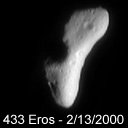|
NEAR
Mission and 433 Eros
The
@stro object for the week of 02/14/2000

image
courtesy of JHUAPL
NEAR Mission
and 433 Eros. On
February 14th, 2000 Johns Hopkins University scientists confirmed
that the Near Earth Asteroid Rendezvous spaceprobe went into orbit
around the asteroid 433 Eros, a near-Earth asteroid that is currently
about 160 million miles from Earth. NEAR becomes the first human-made
satellite to enter into orbit around an asteroid. The mission should
deliver much in the way of scientific data in the form of digital
images, various instrument readings and will collect information
on Eros' mass, structure, geology, composition, gravity and magnetic
field. Potato-shaped Eros is about 21 miles (33 kilometers) long,
8 miles (13 kilometers) wide and 8 miles thick. NEAR was launched
on February 17, 1996 and was supposed to reach Eros two years and
327 days after launch. However, a failed orbit insertion attempt
on Dec. 20, 1998 forced mission designers to add another year and
23 days to the trip. NEAR's operating distance from the surface
of Eros will vary from 300 to 22 miles while in orbit.
NEAR carries
five main scientific instruments:
- A Magnetometer
will determine whether Eros has a magnetic field, which would
indicate the presence of the same metallic iron found in some
meteorites.
- The X-ray/Gamma-Ray
Spectrometer will measure key chemical elements like silicon,
magnesium, iron, uranium, thorium and potassium.
- The Near-Infrared
Spectrometer will map the mineral composition of the surface by
measuring the spectrum of sunlight reflected by Eros.
- The Multispectral
Imager - NEAR's electronic camera - will map the asteroid's shape,
landforms and colors.
- The Laser
Rangefinder will scan the precise shape of the asteroid (within
a meter or two).
more
info on the NEAR Mission
|